Photos
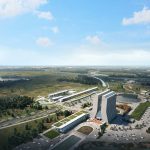
Complex of buildings that will host the PIP-II particle accelerator
This new complex of buildings (center left in this artist rendering), located near Fermilab’s Wilson Hall, will host the 215-meter-long (705-foot-long) PIP-II particle accelerator, which will be the new heart of the Fermilab accelerator complex.
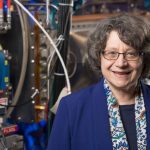
Lia Merminga
Lia Merminga, PIP-II project director, at the PIP-II Injector Test Facility. Photo: Reidar Hahn
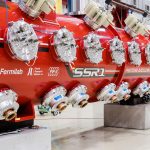
SSR1 cryomodule at PIP2IT
The first Fermilab-built spoke resonator (SSR1) cryomodule at PIP2IT. Photo: Tom Nicol, Fermilab.
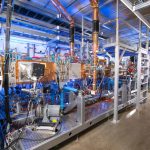
PIP2IT
With help from its partner institutions, Fermilab has built the PIP-II Injector Test Facility, or PIP2IT, a test facility, that houses a systems-integration testbed of the low-energy section, or 20-million electron volts, of the PIP-II accelerator. Scientists and engineers use it to test and optimize the production and delivery of particle beams for the new accelerator. Here, PIP2IT, which was expanded to hold the first two PIP-II cryomodules in 2019, sits in the Cryomodule Test Facility. Photo: Reidar Hahn
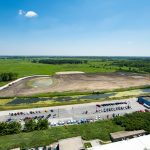
Site of the new linear accelerator for PIP-II as seen from the 16th floor of the lab's Wilson Hall
The new linear accelerator for PIP-II will be installed underground near Fermilab’s Wilson Hall. On July 12, 2019, the cleared site is visible from the 16th floor of the lab’s high-rise. Photo: Reidar Hahn
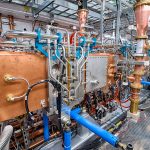
Radio-frequency quadrupole, or RFQ, at PIP2IT
The radio-frequency quadrupole at PIP2IT is operational and meets all PIP-II performance specifications.
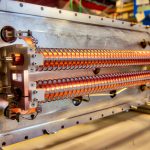
PIP2IT chopper prior to installation
The PIP2IT chopper prior to installation. The chopper cuts excess bunches from the beam to condition it for the superconducting linac. It is operational and meets PIP-II performance specifications.
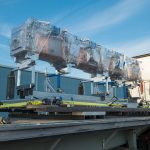
PIP2IT’s radio-frequency quadrupole
PIP2IT’s radio-frequency quadrupole arrives at Fermi National Accelerator Laboratory from Lawrence Berkeley National Laboratory.
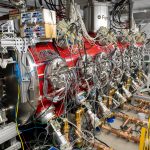
SSR1 cryomodule at the PIP-II Injector Test Facility
The second cryomodule, SSR1, during installation at PIP2IT. This cryomodule is being tested at PIP2IT.
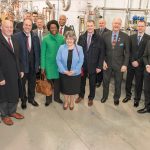
Members of Congress and invited guests visit Fermilab’s PIP-II test stand
On March 15, 2019, members of Congress and invited guests visit Fermilab’s PIP-II test stand while on site for the PIP2IT groundbreaking ceremony. Photo: Reidar Hahn

A technician works on a 325-MHz spoke resonator cavity
A technician works on a 325-MHz spoke resonator cavity for the PIP-II particle accelerator at Fermilab. Photo: Fermilab
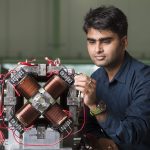
MEBT quadrupole doublet magnet
MEBT quadrupole doublet magnet delivered by BHABHA Atomic Research Center in 2015. Photo: Fermilab
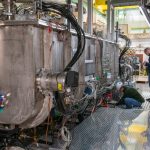
Technicians work on the half-wave resonator (HWR) at PIP2IT
Technicians work on the half-wave resonator (HWR) at PIP2IT. Photo: Ryan Postel, Fermilab
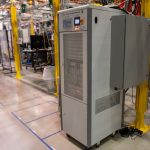
325 MHz radiofrequency power amplifier for the SSR1
The 325 MHz radiofrequency power amplifier for the SSR1, installed at PIP2IT after delivery from BARC, Mumbai, India. Photo: Fermilab
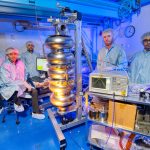
Fermilab engineers and Department of Atomic Energy visitors pause work to pose next to a 5-cell 650 MHz superconducting radio frequency cavity
Fermilab engineers and Department of Atomic Energy visitors pause work to pose next to a 5-cell 650 MHz superconducting radio frequency cavity being tuned for PIP-II. Photo: Reidar Hahn
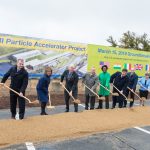
Fermilab breaks ground on the PIP-II accelerator project, joined by dignitaries from the United States and international partners on the project
On Friday, March 15, Fermilab broke ground on the PIP-II accelerator project, joined by dignitaries from the United States and international partners on the project. From left: Senator Tammy Duckworth (IL), Senator Dick Durbin (IL), Rep. Sean Casten (IL-6), Rep. Robin Kelly (IL-2), Rep. Bill Foster (IL-11), Fermilab Director Nigel Lockyer, Rep. Lauren Underwood (IL-14), Illinois Governor JB Pritzker, DOE Under Secretary for Science Paul Dabbar, PIP-II Project Director Lia Merminga, DOE Associate Director for High Energy Physics Jim Siegrist, University of Chicago President Robert Zimmer, Consul General of India Neeta Bhushan, British Consul General John Saville, Consul General of Italy Giuseppe Finocchiaro, Consul General of France Guillaume Lacroix, DOE Fermi Site Office Manager Mike Weis, DOE PIP-II Federal Project Director Adam Bihary and Consul General of Poland Piotr Janicki. Credit: Fermilab

Group photo at Fermilab
Fermilab_PIP-II_Banner_191503
Shortly after breaking ground on the PIP-II accelerator project on Friday, March 15, Fermilab employees were joined by the governor of Illinois, six members of Congress and partners from around the world in this group photo. Photo: Fermilab
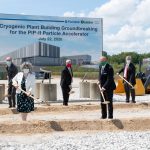
Fermilab and partners broke ground on the new PIP-II cryoplant building
On Thursday, July 22, Fermilab and partners broke ground on the new PIP-II cryoplant building. From left: DOE Fermi Site Office Manager Roger Snyder, Fermilab PIP-II Project Manager Marc Kaducak, Fermilab PIP-II Project Technical Director Arkadiy Klebaner, Fermilab PIP-II Project Director Lia Merminga, DOE Fermi Site Office Federal Project Director Steve Neus, DOE Under Secretary of Science Paul Dabbar, Fermilab PIP-II Conventional Facilities Manager Steve Dixon, Fermilab Director Nigel Lockyer, Fermilab PIP-II In-kind Contribution Technical Integration Manager Allan Rowe, DOE PIP-II Federal Project Director Adam Bihary. Credit: Fermilab
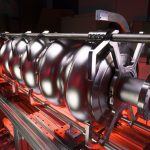
Five-cell, 650-MHz superconducting radio-frequency cavity
Cooled with liquid helium to below minus 270 degrees Celsius (minus 454 degrees Fahrenheit), this five-cell, 650-MHz superconducting radio-frequency cavity is one of the central features of the PIP-II particle accelerator project at Fermilab. PIP-II will use strings of these cavities to propel particles to about 800 million electronvolts, or 84 percent of the speed of light. Credit: Fermilab
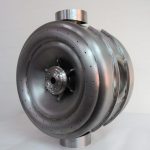
First SSR1 niobium resonator built by the Inter-University Accelerator Centre
First SSR1 niobium resonator built by the Inter-University Accelerator Centre, delivered to Fermilab in 2015. Photo: IUAC
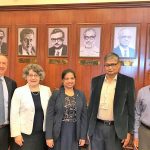
Indian Department of Energy and Fermilab officials meet in India in 2018
Indian Department of Energy and Fermilab officials meet in India in 2018. From left: Fermilab Director Nigel Lockyer, PIP-II Project Director Lia Merminga, Fermilab Chief of Staff Hema Ramamoorthi, Chairman of the Indian Atomic Energy Commission and Secretary to the Government of India, Department of Atomic Energy Sekhar Basu, and Satish Joshi (RRCAT). Photo: Fermilab
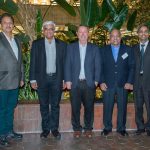
Fermilab Director Nigel Lockyer meets Indian scientists in the Wilson Hall atrium in 2016
Fermilab Director Nigel Lockyer meets Indian scientists in the Wilson Hall atrium in 2016. From left: Vikas Jain (RRCAT), Srinivas Krishnagopal (BARC), Nigel Lockyer (Fermilab), Satish Joshi (RRCAT), Kumar Ranajit (DAE). Photo: Fermilab.
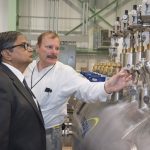
Chairman of the Indian Atomic Energy Commission and Secretary to the Government of India, Department of Atomic Energy Sekhar Basu discusses cryogenics with Fermilab engineer Rich Stanek
Chairman of the Indian Atomic Energy Commission and Secretary to the Government of India, Department of Atomic Energy Sekhar Basu discusses cryogenics with Fermilab engineer Rich Stanek during a visit to the laboratory in 2014. Photo: Fermilab.
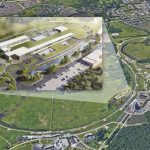
2019 artist rendering of the Fermilab's campus and the PIP-II accelerators
This artist rendering, updated in March 2019, shows what Fermilab’s campus will look like when the new PIP-II accelerators have been added. Illustration: Diana Brandonisio
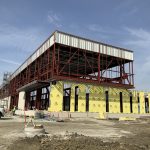
PIP-II cryoplant construction
PIP-II cryoplant construction
In May 2021, the construction of the cryoplant building for PIP-II is well underway on the Fermilab campus. Photo: Ernesto Alcaraz

Half-wave resonator cryomodule transported to ICB
Half-wave resonator cryomodule transported to ICB
After successfully accelerating beam in PIP2IT, the half-wave resonator cryomodule was transported back to APS-TD ICB, where it will be prepared for long-term storage before installation in PIP-II. Photo: Cristian Boffo

2021 rendering of the complex of buildings that will host the PIP-II particle accelerator
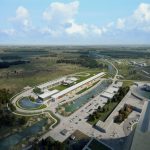
2021 rendering of the complex of buildings that will host the PIP-II particle accelerator

2021 rendering of the complex of buildings that will host the PIP-II particle accelerator




